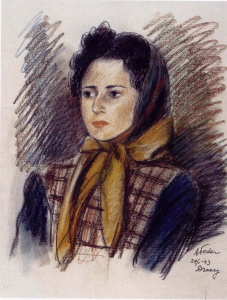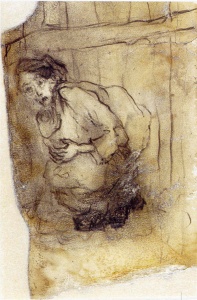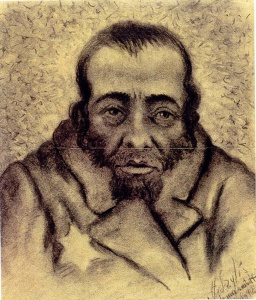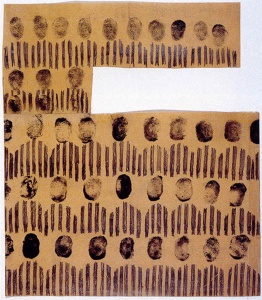At The Brooklyn Museum
The Holocaust was the largest mass murder in human history. It casts an indelible shadow over everything that follows, twisting morality and normative values in unfathomable ways. The vast complicity of Western Civilization in the pre-meditated murder of six million Jews taints all culture and intellectual life to this day. Gazing through this lens humanity appears at its most obscene and vicious. Returning to those years and revisiting the events that transpired through the eyes of the victims is a deeply painful yet necessary experience. It must be done repeatedly if for no other reason than to forge a communal experience to insure it will never happen again. As the victims of this crime, we Jews have the double responsibility to never allow ourselves to become that vulnerable, and to teach mankind it must rise above its basest nature.
The Last Expression: Art and Auschwitz, on exhibit at the Brooklyn Museum through June 15, confronts us with one means to accomplish this responsibility. The vehicle is most surprisingly the visual arts. Over two hundred works of art made during the Holocaust by prisoners at Nazi death camps, concentration camps and in ghettos such as Warsaw and Lodz make a complex case for the will to life insisted upon by these victims. And yet it is difficult to know whether this exhibition is a cause to celebrate the indomitable human spirit of creativity in the face of evil or a shameful realization that we were powerless to defend our people against such depravity. It may be that the only moral response to human evil flows out of the barrel of a gun. Visitors must decide for themselves.
This exhibition is not exclusively about the Jewish Holocaust. Jews and non-Jewish victims of Nazi terror are represented in such a way that the question, “Was this artist a Jew?” begins to fade in importance. Considering the common brutality exhibited towards criminals, political prisoners, Roma (gypsies), homosexuals and Jews, making distinctions between the artist/victims becomes more than a little embarrassing. The shades of terror tend to blur between Jew and Gentile, with one important difference; the vast majority of Jews were sent to extermination camps, such as Birkenau-Auschwitz and were murdered immediately. The chance of a Jewish “Last Expression” was tragically slim.
The art in this exhibition is overwhelmingly documentary in nature, providing a record of fleeting humanity as the macabre machine of death consumed millions. Often suffering and terror are depicted alongside simple portraits that attest to the importance of one single life.
The exhibition is divided into thematic sections. “Art on Command” consists of paintings by mostly Polish prisoners at the order of Nazi guards for decoration and entertainment. Auschwitz and Theresienstadt both had art studios for painting, sculpture and printmaking. When not exterminating or starving its prisoners to death, these camps had complex bureaucracies that provided the opportunities for those determined enough to obtain pencil, paper and even occasionally paint to make clandestine art. Once completed, artworks were either smuggled out or hidden in the camp. Those who survived returned after liberation to retrieve their artworks.
“Letters, Card and Books” are also by Polish prisoners, including decorated letters, a remarkable book, “Fable of the Hare, Fox and Rooster” and various satirical postcards attacking the German invaders.

The images in “Individuals as Subjects” are haunting. Each person’s story, as far as it is known, is patiently documented next to the portrait. Not one image is exceptional, until one understands the conditions under which it was created and the fate of its subject. The pensive simplicity of Aizik-Adolphe Feder’s (1887-1943) Portrait of a Lady with a Kerchief (1943), drawn in the Drancy transit camp, impresses upon us the fragility of human life. Feder was an artist and resistance fighter who did many portraits of fellow prisoners at Drancy. Most internees, including Feder, were deported from Drancy to Auschwitz. He died there.

Halina Olomucki (b.1921) was a young artist when her family was forced into the Warsaw Ghetto. There she made numerous drawings, documenting deportations, the ghetto revolt and the liquidation of Dr. Korczak’s orphanage. She was deported in 1943 first to Majdenek and then to Auschwitz-Birkenau where she made over 200 clandestine drawings in the camps. She survived and eventually emigrated to Israel in 1972. Eight of her works are shown here, including Smuggling Food, 1943, fulfilling her fellow prisoners’ demand, “draw me, so that at least we will go on living in your work.”

Hirsch Szylis (1909-1987), a prominent Polish/Jewish artist before the war, managed to paint five remarkable paintings of the Lodz ghetto each shown here. His Ghetto Resident with Jewish Badge (1942) is possibly one of the outstanding images of the exhibition. Szylis was deported to Auschwitz and finally to Dachau from where he was liberated. In 1957 he emigrated to Israel and devoted the majority of his work to ghetto scenes done from memory. For this artist the horror seems to have never ended.
The images from the ghettos of Lodz and Warsaw follow works from Theresienstadt, the “model camp” located in Czechoslovakia. This series, especially those by Leo Haas (1901-1983) provide the most visible depiction of the wretched living conditions in both the ghetto and the camps. The endless toil, crowding, suffering and painful deaths are present on every page of his drawings.
The last grim section of the exhibition is “Life in the Camps.” It chronicles a punitive roll call that could last most of a day standing in the brutal cold and snow, arriving transports and cruel murders of prisoners. An official documentary film is shown in the very last gallery. It is extremely difficult to watch. It was filmed from March 1 through May 8, 1945 and documents the liberation of the camps by the American Army. Tragically this depiction of carnage and mass graves is a necessary reminder of what happened to those who did not survive or escape. Many of those captured in an artist’s image were swallowed in this unspeakable final atrocity.

Returning from that last room you walk back through the exhibition and are reminded of the attempts of artists and inmates to salvage their humanity by setting down an image on paper. One image by Jozef Szajna (b1922), a non-Jew, in a way sums up the anonymity of victimhood. Our Biographies (ca 1944-45) depicts forty-one prisoners as thumbprints attached to the stripes of their uniforms. Each thumbprint, theoretically unique but here a mere cipher, is emblematic of the artist’s despair. This work encapsulates our own despair and shame. These scraps of paper cannot overcome the mountains of bodies. But it is all we have. And these scraps of individuals captured in fleeting artworks we will remember.
The Last Expression: Art and Auschwitz
Works from Auschwitz-Birkenau State Museum, Yad Vashem, US Holocaust Memorial Museum and others
Brooklyn Museum of Art
200 Eastern Parkway, Brooklyn, NY
Scholarly Catalogue available, edited by David Mickenberg, Corinne Granof and Peter Hayes;
Published by Mary and Leigh Block Museum of Art and Northwestern University Press
Published in The Jewish Press